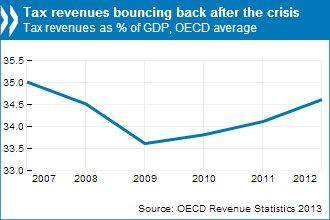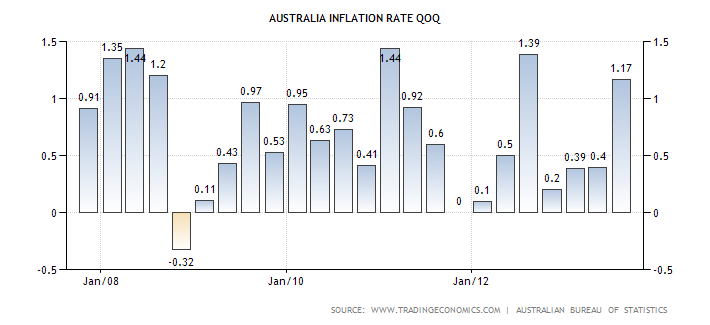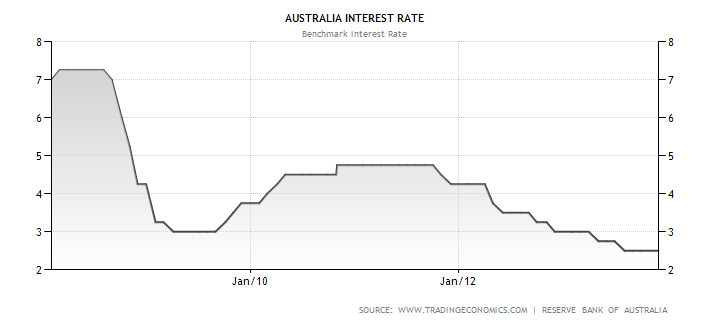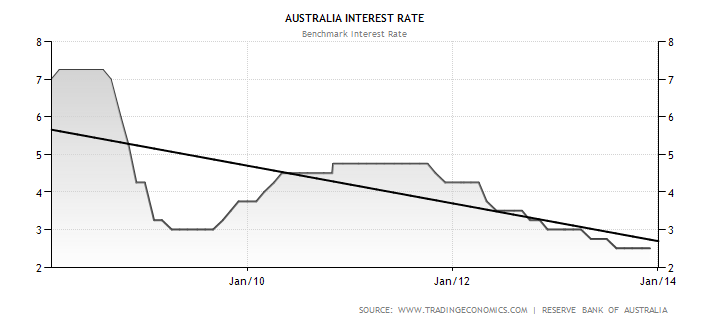Introduction
The Australian financial system is one of the economies in the developed world that had a better performance both in the wake of and after the global financial crisis. Several reasons have been fronted for the positive performance of the economy. There are sets of data that show that the economy was resilient, with a high probability of continuing to be on the right path. Some of the important indicators of economic performance include the inflation rate, unemployment rates, the Gross Domestic Product and the rate at which it is changing, the debt-to-GDP ratio of a country, and other rates such as interest rates. This essay focuses on the economic performance of the Australian economy post the global economic crisis using the above measures. It also looks at the monetary and fiscal policies that were important in this performance.
Inflation
Inflation is one of the factors in economics that was heavily affected by the global economic crisis. Many households were unable to acquire basic commodities because of the same. Countries try to reduce inflation to ensure that goods and services are affordable by their population. This ensures that there is also some money available for government spending in the form of tax as shown in graph 1 below.

Australia is one of the nations where inflation continues to be a priority for the different administrations. The trend after the global economic crisis is not different from most other nations. Australia experienced a surge in the inflation rate after the global financial crisis, with the value standing at 0.91%, which was considerably high about the previous years. The inflation rate continued to rise throughout the year, with the highest recorded for the same year being 1.44% (“Trading Economics: Australia Inflation Rate QoQ” par. 1). Graph 2 below gives detailed information on this figure.

2009 has a relatively lower inflation rate compared to the previous years. January had one of the lowest rates reaching -0.32%. The highest recorded inflation rate for this year is 0.97. The value continued to oscillate throughout the year (“Trading Economics: Australia Inflation Rate QoQ” par. 1). 2010 started with a relatively high inflation rate of 0.95%. Nevertheless, this was the highest level reached for that year. As it was witnessed in 2010, 2011 started with a high inflation rate, which matched the highest of 2008 at 1.44%. This rate would, however, drop to reach a low of 0% by the end of the year, with the following year of 2012 starting at a low of 0.1% (“Trading Economics: Australia Inflation Rate QoQ” par. 1).
2012 had a significantly improved performance, although the inflation at one time went up to 1.39, which was the second-highest that the rate had been in the last several years. Despite the challenge in keeping the inflation constant, the country managed to stem it in 2013, with the beginning months having a significantly low inflation rate at an average of 0.4% for the first half of the year. A high rate of 1.17% would, however, be recorded in the last few months after the first half of the year (“Trading Economics: Australia Inflation Rate QoQ” par. 1).
Unemployment
The unemployment rate of any country is one of the indicators of economic performance. Any country that can reduce unemployment is likely to experience negative growth. Australia has been able to reduce its unemployment rates throughout the decades. However, unemployment has continued to be a rampant problem in any administration.
In the period between 2008 and 2013, the Australian economy reported poor performance, with unemployment increasing and thereafter remaining steady. 2008 saw the development of the global financial crisis. This year had the lowest unemployment rate of the last five years at about 4.3 % of the population. After the global economic crisis, companies started offloading their workers to maintain profit, with unemployment increasing up to about 4.5% of the population. This increase was the highest for a long period. The government would start to institute measures to curb this unemployment. Despite these measures, the rate of unemployment rose to another high of over 5.7% recorded in 2010.
The measures put in place at the end of the year such as the reduced spending and the withholding of any layoffs together with better economic performance meant that the unemployment rate would reduce. Due to this situation, the unemployment rate reduced to a low of 5.8% in one of the months in 2011. 2012 started with a rather high unemployment rate of 5.2%. This continued to rise throughout the year. The rise in unemployment continued steadily through 2013, with December closing with an unemployment rate of 5.8% of the population.
Real GDP per capita Growth
The GDP per capita is another indicator of economic performance. Nations also try to estimate and calculate this value to assess their financial performance. Australia is one of the nations that have been performing well on this front. The GDP per capita has been good before the global economic crisis. The GDP per capita had been on a constant increase before 2008. This rise continued even after the passing of the crisis.
In 2008, the GDP per capita in constant 2000 US dollars divided by the mid-year population stood at 35232.59. This value further increased over the next one year. By 2009, the value stood at 35930.46. The increase continued to be observed over the next year. While other economic values reduced or reacted to the global economic crisis, this value came to stand at 35861.25 in 2010. This was the only reduction in value, with other years recording an increase.
The year 2011 was another year where the increase was observed, with the value standing at 36134.54, which was another remarkable year. In 2012, the value rose again to an all-time high of 36584.99. This increase was motivation for the economy. The values continued on a positive trend, with a 2013 closing with a value of 37228.2. The period of 2014 is likely to have a continuation of the same trend. The likely scenario is an increase in value. Some of the factors that have made the GDP per capita resistant change even in the wake of the global financial crisis include the government policies that have been put in place and the fiscal and monetary policy existing over the years.
Debt GDP Ratio
Government debt can be expressed as a ratio of the GDP. This ratio is often referred to as the government Debt-to-GDP ratio (Freedman et al. 45). This ratio shows the amount of debt that a country has about its GDP. The debt, in this case, is the amount of money that the central government of any nation owes its creditors. The government debt can be expressed as either net or gross debt, with gross debt being the cumulative amount of money that the government owes in the form of bonds, credit swaps, and pensions. The calculation of net debt is done with the subtraction of the government’s financial assets from the gross debt. This figure provides a basis for establishing whether a government can pay its debts. If the debt to GDP ratio is high, the ability of a nation to repay its debts is reduced.
For the case of Australia, the Debt-to-GDP ratio was well under control. It has always been before the economic crisis of 2008. During 2008, the Debt-to-GDP stood at 9.7%. This figure is the lowest that it has been ever since. The country’s debts continued to increase over the next years. The ratio had reached 11.8% by 2009. The dawn of 2010 saw the most considerable increase of all the years, with the ratio reaching an all-time high of 16.9% during this year. The measures put in place to stem the sire in this ratio were not enough to reduce it. However, in the year that followed, the ratio stood at 20.4%, which was also a significant rise.
The rate of change in the Debt-to-GDP ratio continued for the next year. In 2012, the ratio had reached 22.9% of the GDP. Adequate measures were put in place according to the change that was observed in 2013. The Debt-to-GDP ratio managed to reduce to 20.7%. This was however still high about the previous years before 2008. The trend seems to be maintained for the year 2014. If the right measures will be put and maintained in place, the ratio will continue to reduce the value that was witnessed before the crisis.
Interest Rates
The interest rates are some of the measures of economic performance that were adjusted by most nations after the onset of the global financial crisis, with Australia being no exception. In the wake of the global economic crisis, Australia had a good performing banking industry. This was affected by all other banking industries elsewhere in the world. The interest rates are at the end of 2008 stood at 7.2% (“Trading Economics: Australia Interest Rate” par.1). This value is the highest that the rates have been for the last five years. With the various adjustments being made by the central bank, the interest rates fell considerably, with September having interest rates of 3%.
After this month, the rates began to rise again until the middle of 2010 where the rates stood at 4.5% (“Trading Economics: Australia Interest Rate QoQ” par. 1). The rates continued to increase for that year and reached another high on 4.8% where they would stagnate for a considerable amount of time. The same value was also applicable as of 3rd May 2011. The interest rates have fallen since then, with 2012 having an interest rate of approximately 4%. In 2013, the rates continued to fall until they stagnated at 2.5% (“Trading Economics: Australia Interest Rate” par. 1). The year also had an average of 2.5% in interest rates. Graph 3 below has more information about this indicator, with graph 4 showing the trend.


The relatively low-interest rates observed in Australia were maintained because of active policies to stem the effects of the global financial crisis. These policies had a visible effect on all areas of life including the inflation rates and the cost of living. Australians were therefore not the worst hit by the global financial crisis as other nations in the world.
Fiscal and Monetary Policies
Australia did not go through some of the bad economic effects of the global financial crisis as compared to other developed countries as the data discussed above shows. One of the measures that have been attributed to this observation is the fiscal policy that the government put in place to stem the effects of the GFC (Freedman et al. 34). The country is described as instituting measures such as protection of household incomes and inclusion of large-scale infrastructure projects in the budgets. Another of the fiscal policies is the cash stimulus that the government developed to support households. This policy was part of the economic stimulus that the administration at the time embarked on.
The monetary policies that were instituted in the wake of the global financial crisis were responsible for the positive performance of the Australian economy after the global economic crisis. There were assumptions that the fiscal policy was responsible for the observed economic strength. Following the assertion that the fiscal policy was responsible for the recovery of the Australian economy after the global economic crisis, Makin performed research using the four-variable VAR model. The results indicated that the assertions were incorrect (Makin 201). Their assessment indicated that the monetary policies put in place were responsible for the positive performance.
The monetary policies put in place in Australia during and after the global financial crisis were well organized and timed, with the effects being commendable. One of the policies was the control of interest rates as stated above in a previous section. The interest rates are described as oscillating in the period between the global financial crisis and the present. These rates were because of the tight control that the central bank had managed to attain. The meeting for the control of interest rates set the fixed interest rate at 2.5% for 2014. This has been in effect even for 2013 (Makin 201). The control of interest rates is one of the monetary policies that the government has put in place to ensure that the economy does not succumb to pressure after the economic crisis and even if other crises were to occur.
Conclusion
It is crucial to assess the performance of a country within a certain period in the effort of finding out the trend that it is taking. This information may be of much help to the country in terms of laying the basic policies and strategies to manage the performance. The Australian economy was one of the economies of the developed world that had a relatively good response to the global financial crisis that hit the world during the period of 2007/2008. A focus on the economic performance of this country shows that the reasons for the resilience include some of the measures that were put in place. These include monetary and fiscal policies. The economic indicators that are put into focus in this paper show that the country is still performing positively, with the predictions for the next year tending to be positive.
Works Cited
Freedman, Charles, Michael Kumhof, Douglas Laxton, Dick Muir, and Susan Mursula. “Global Effects of Fiscal Stimulus during the Crisis.” Journal of Monetary Economics 57.5(2010): 506-526. Print.
Makin, Ann. “Did Australia’s Fiscal Stimulus Counter Recession?: Evidence from the National Accounts.” Agenda 17.2(2010): 5-16. Print.
OECD Revenue Statistics 2013. Web.